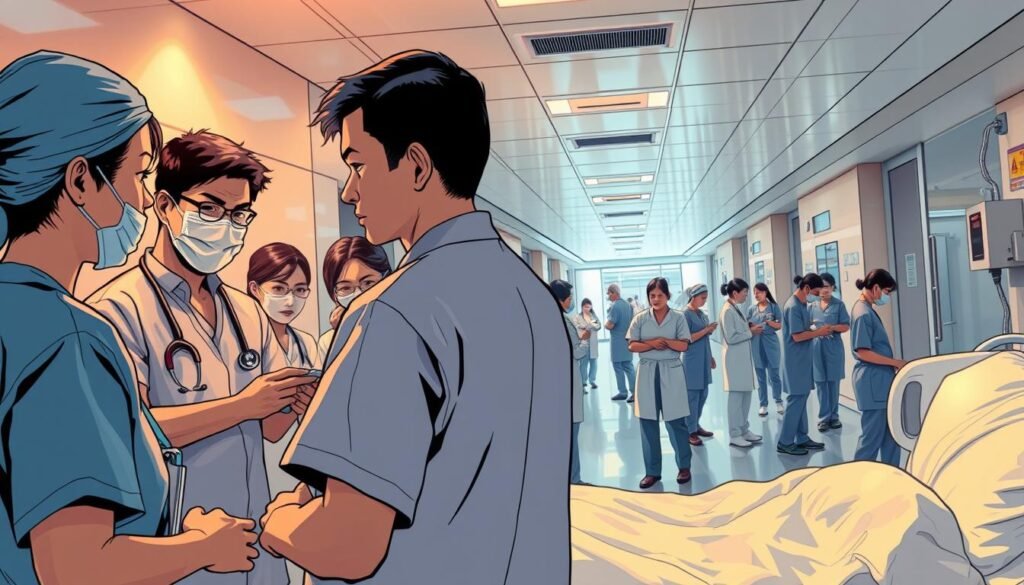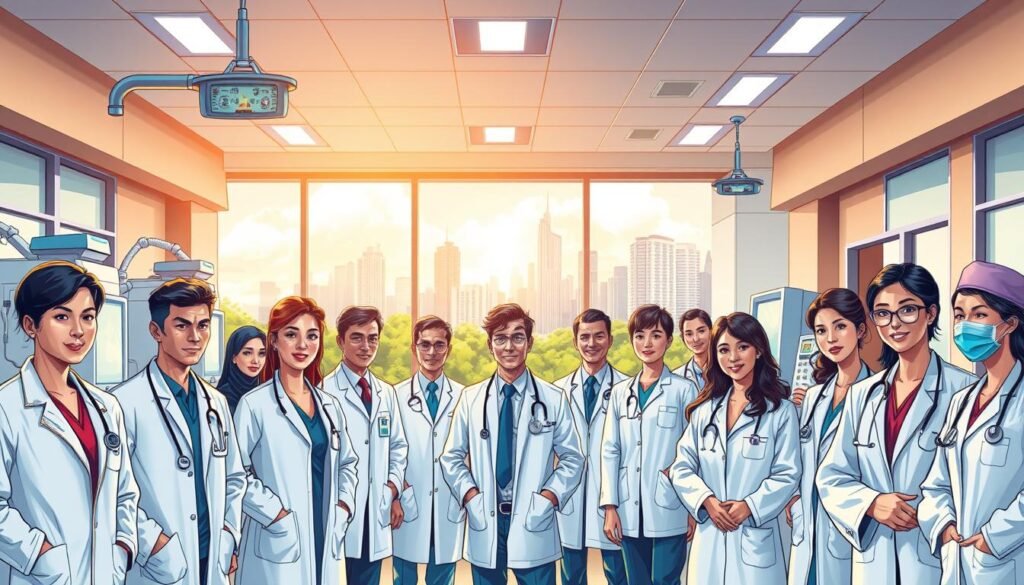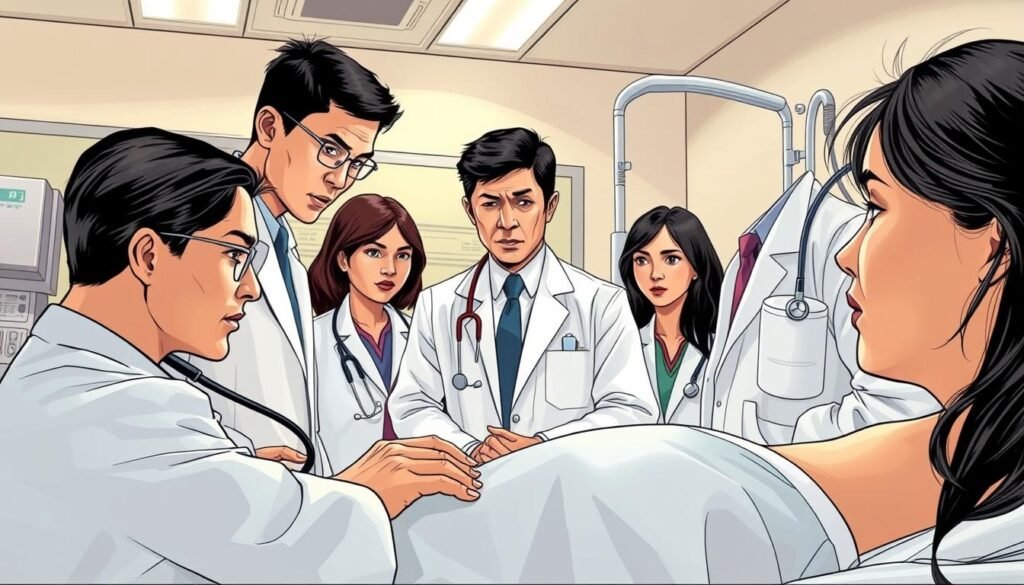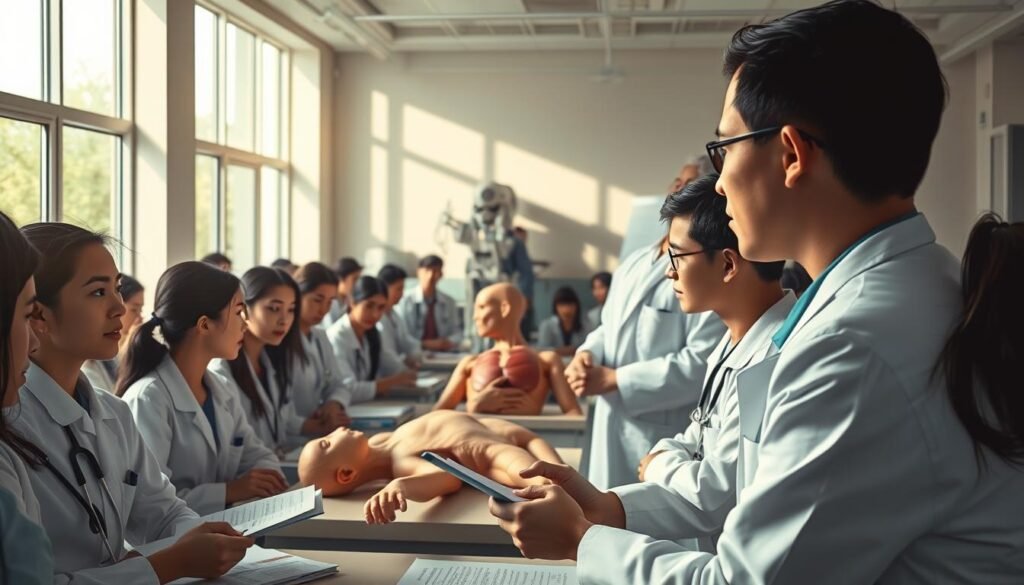Filipino doctors and nurses are essential pillars of the healthcare system, both in the Philippines and globally. Their dedication, expertise, and compassion have made a significant impact on patient care and community health. These professionals are celebrated for their ability to deliver high-quality medical services, often under challenging conditions.
In the Philippines, medical doctors and nurses work tirelessly to address the needs of patients. They are trained to handle a wide range of health issues, from routine check-ups to complex surgeries. Their collaborative efforts ensure that every patient receives the best possible care.
Despite facing challenges like resource limitations and high workloads, Filipino healthcare workers remain committed to their mission. Their contributions are vital to the success of the healthcare system, making them indispensable in the field of medicine.
Key Takeaways
- Filipino doctors and nurses are crucial to the healthcare system.
- They provide high-quality care with compassion and expertise.
- Collaboration among medical professionals ensures effective patient treatment.
- They face challenges but remain dedicated to their work.
- Their contributions are vital to community health and well-being.
Introduction
Modern healthcare in the Philippines is shaped by the expertise of dedicated medical workers. These professionals are trained to diagnose treat a wide range of health issues, ensuring patients receive the best possible care. Their roles are vital in addressing both common and complex medical conditions.
Filipino healthcare workers, including doctors and nurses, are known for their compassion and skill. They often specialize in areas like surgery, internal medicine, and preventive care. Their training equips them to handle everything from routine exams to emergency treatments.

Community involvement is another key aspect of their work. Many professionals focus on improving public health through education and preventive measures. This approach helps reduce the prevalence of chronic conditions and other health issues.
Medical exams and tests are essential tools in their practice. These procedures allow them to accurately identify problems and recommend effective treatments. Whether it’s a simple blood test or a complex imaging study, these methods are crucial for patient care.
Here’s a quick overview of the roles and specialties in Philippine healthcare:
| Role | Specialty | Key Responsibilities |
|---|---|---|
| Surgeon | Surgery | Performing operations to treat injuries or diseases |
| Primary Care Doctor | General Medicine | Diagnosing and treating common health issues |
| Nurse | Patient Care | Assisting doctors and providing direct patient support |
As we explore further, we’ll delve into the importance of these roles, the challenges they face, and the innovations shaping their work. Stay tuned for a deeper look into the world of Philippine healthcare.
The Importance of Healthcare in the Philippines
Access to quality healthcare is a cornerstone of a thriving community in the Philippines. It ensures that families can lead healthier, more productive lives. Hospitals and clinics play a central role in providing essential services to the public.

A strong healthcare system is vital for managing various conditions and diseases. From routine check-ups to emergency treatments, these facilities address a wide range of health issues. Proper training for medical professionals ensures they can handle complex cases effectively.
Public health initiatives, such as testing and education, are crucial for preventing illnesses. These efforts reduce the burden on the healthcare system and improve overall community health. For example, early detection of diseases like cancer can lead to more successful treatments.
Investments in healthcare infrastructure and training are essential. They help build a resilient system that can adapt to modern challenges. This ensures that every family, especially children, receives the care they need.
Here are some key benefits of a robust healthcare system:
- Supports families and communities by providing accessible care.
- Reduces the prevalence of chronic conditions through preventive measures.
- Protects children and ensures their healthy development.
- Improves public health through organized testing and education.
By prioritizing healthcare, the Philippines can create a healthier future for its people. A well-organized system not only saves lives but also strengthens the nation’s overall well-being.
The Dual Impact: Filipino Doctors and Nurses
The partnership between Filipino doctors and nurses is a cornerstone of effective healthcare delivery. Their combined expertise ensures that patients receive comprehensive and compassionate care. This collaboration is especially vital in managing complex conditions and disorders.

Doctors focus on diagnosing and treating patients, while nurses provide round-the-clock support. This teamwork is essential in critical situations, such as surgeries or emergencies. Nurses often work closely with doctors to monitor patients and ensure treatments are effective.
Family-centered care is another key aspect of their work. By involving families in the recovery process, medical professionals create a supportive environment. This approach not only improves patient outcomes but also strengthens community health.
“When doctors and nurses work together, the results are transformative. Patients feel cared for, and recovery becomes a shared goal.”
Real-world examples highlight the effectiveness of this dual impact. During the pandemic, Filipino nurses and doctors united to tackle unprecedented challenges. Their teamwork saved countless lives and showcased the resilience of the healthcare system.
Here are some ways their collaboration enhances healthcare:
- Doctors diagnose and treat, while nurses ensure continuous care.
- Teamwork improves the management of chronic conditions.
- Family involvement speeds up recovery and builds trust.
- United efforts during emergencies lead to better outcomes.
This dual impact also boosts job satisfaction. Working together allows professionals to share responsibilities and celebrate successes. It creates a positive work environment that benefits both staff and patients.
Exploring Medical Specialties in the Philippines
The Philippine healthcare system thrives on a diverse range of medical specialties. These fields ensure that patients receive tailored care for their unique health needs. From routine check-ups to complex surgeries, the system is designed to address a wide spectrum of conditions.

Primary and Preventive Care
Primary care is the foundation of the healthcare system. It focuses on routine check-ups, immunizations, and preventive measures. These services help detect health issues early and reduce the risk of chronic conditions.
Preventive care plays a crucial role in maintaining community health. By educating patients about healthy lifestyles, primary care professionals reduce the burden on hospitals. This approach ensures that families stay healthy and productive.
Advanced Specializations and Subspecialties
Advanced specializations address complex health issues. Fields like cardiology, oncology, and neurology require additional training and expertise. These specialties focus on specific areas of the body, such as the heart, brain, or bones.
Subspecialties take this focus even further. For example, a cardiologist may specialize in pediatric heart conditions. This level of expertise ensures precise diagnosis and effective treatment for patients.
Here are some key benefits of having diverse medical specialties:
- Comprehensive care for a wide range of conditions.
- Specialized treatment options for complex health issues.
- Improved patient outcomes through precise diagnosis.
- Support for families by addressing specific health needs.
The evolution of medical specialties has transformed healthcare delivery in the Philippines. By offering both primary and advanced care, the system ensures that every patient receives the best possible treatment.
Doctors and Their Vital Role in Patient Care
In the heart of healthcare, professionals play a pivotal role in diagnosing and treating a wide range of conditions. Their expertise ensures that patients receive the best possible care, whether it’s managing chronic pain or addressing sudden injuries. Every day, these medical experts work tirelessly to improve health outcomes.

One of the key responsibilities of doctors is to accurately diagnose health issues. They use a combination of physical exams, medical history, and advanced tests to identify the root cause of a problem. This process is crucial for developing effective treatment plans tailored to each patient’s needs.
Managing pain is another critical aspect of patient care. Whether it’s acute pain from an injury or chronic discomfort, doctors employ various methods to alleviate suffering. This includes medications, physical therapy, and sometimes surgical interventions. Their goal is to restore comfort and improve quality of life.
Injuries, whether minor or severe, require immediate attention. Doctors are trained to handle everything from fractures to complex trauma. They work closely with other healthcare providers to ensure comprehensive care. For example, orthopedic surgeons specialize in treating musculoskeletal injuries, while emergency medicine experts handle life-threatening situations.
Here’s a closer look at how doctors address different health issues:
| Health Issue | Treatment Approach |
|---|---|
| Chronic Pain | Medications, physical therapy, and lifestyle changes |
| Injuries | Immediate care, surgery, and rehabilitation |
| Emergency Conditions | Rapid diagnosis and life-saving interventions |
Compassion and professionalism are at the core of patient care. Doctors not only treat physical ailments but also provide emotional support. This holistic approach ensures that patients feel valued and understood throughout their recovery journey.
From routine check-ups to emergency surgeries, doctors are dedicated to improving health outcomes. Their commitment to excellence and patient-centered care makes them indispensable in the healthcare system.
The Journey of Becoming a Medical Professional in the Philippines
Becoming a medical professional in the Philippines is a journey marked by dedication, rigorous training, and continuous learning. This path is designed to equip aspiring professionals with the skills needed to diagnose treat a wide range of conditions effectively. From classroom learning to hands-on experience, every step prepares them for the challenges of the field.

Training and Residency Programs
Aspiring medical professionals begin their journey with a bachelor’s degree, often in fields like nursing or biology. After completing the National Medical Admission Test (NMAT), they enter medical school for a four-year program. This phase focuses on both theoretical knowledge and practical skills.
Clinical rotations are a critical part of medical training. Students gain hands-on experience in various specialties, such as surgery, internal medicine, and pediatrics. These rotations help them understand the complexities of different conditions and procedures.
After medical school, graduates must pass the Physician Licensure Exam to become certified. Residency programs follow, lasting 3 to 6 years depending on the chosen specialty. During this time, residents work under supervision, honing their skills in real-world settings.
Continuing Education and Additional Training
The learning doesn’t stop after residency. Medical professionals must engage in continuing education to stay updated on advancements in medicine. This includes attending workshops, conferences, and specialized courses.
Additional training is often required for those pursuing subspecialties. For example, a surgeon may undergo further training in minimally invasive procedures. This ensures they can provide the best possible care for their patients.
Here’s a summary of the typical pathway to becoming a certified medical professional:
| Stage | Duration | Key Activities |
|---|---|---|
| Pre-Medical Education | 4 years | Bachelor’s degree in a related field |
| Medical School | 4 years | Theoretical learning and clinical rotations |
| Licensure Exam | Varies | Physician Licensure Exam |
| Residency | 3-6 years | Specialized training and hands-on experience |
| Continuing Education | Ongoing | Workshops, conferences, and additional training |
This demanding journey requires unwavering commitment. However, the reward is the ability to make a meaningful impact on patients’ lives. Whether it’s performing a complex surgery or managing chronic conditions, medical professionals play a vital role in healthcare.
Emergency and Critical Care Services
Emergency and critical care services are the backbone of life-saving interventions in the Philippines. These services are designed to respond swiftly to life-threatening situations, ensuring patients receive immediate and effective treatment. Whether it’s a severe injury or a sudden illness, emergency teams are trained to act decisively.

Rapid diagnosis is crucial in emergency settings. Medical professionals use advanced tools like blood tests and imaging to identify the root cause of a problem. This allows them to administer the right drugs or perform necessary procedures without delay. Every second counts when saving lives.
In critical situations, surgeons and emergency teams often work together to stabilize patients. For example, trauma care requires immediate surgery to address internal bleeding or fractures. These professionals are trained to handle high-pressure scenarios with precision and calmness.
“In emergencies, teamwork and technical skill are as vital as medical knowledge. It’s about saving lives, one decision at a time.”
Emergency care isn’t limited to accidents. It also addresses sudden illnesses like heart attacks or severe infections. In these cases, rapid treatment can prevent complications and improve outcomes. Proper drug administration, such as pain relief or antibiotics, plays a key role in patient recovery.
Here’s how emergency services function during critical moments:
- Rapid diagnosis using tests and imaging.
- Immediate treatment to stabilize the patient.
- Coordination between surgeons and emergency teams.
- Proper drug administration to manage pain and infections.
Teamwork is essential in emergency care. From paramedics to surgeons, every member of the team plays a vital role. Their combined efforts ensure that patients receive comprehensive care, even in the most challenging situations. For more insights into healthcare systems, explore this resource.
Emergency and critical care services are a testament to the dedication and skill of medical professionals. Their ability to act swiftly and effectively saves countless lives, making them indispensable in the healthcare system.
Pediatric and Family Medicine in Action
Pediatric and family medicine work hand in hand to ensure the well-being of children and their families. These fields focus on providing specialized care for young patients while supporting long-term health through preventive measures. By combining expertise, pediatricians and family physicians create a comprehensive approach to healthcare.

Child Health and Preventive Measures
Pediatricians play a vital role in safeguarding the health of children. They conduct regular exams to monitor growth, development, and overall well-being. From infancy to adolescence, these professionals address a wide range of health issues, ensuring that every child receives the care they need.
Preventive measures are a cornerstone of pediatric care. Vaccinations, routine checkups, and health education help reduce the risk of illnesses. Early diagnosis and treatment are crucial for managing conditions effectively. This proactive approach ensures that children grow up healthy and strong.
- Pediatricians provide specialized care tailored to young patients.
- Routine exams and vaccinations are essential for preventive care.
- Early diagnosis helps manage health issues before they escalate.
- Family-based care fosters trust and continuity in treatment.
Family physicians complement the work of pediatricians by offering care for the entire family. They focus on long-term health, addressing issues that affect both children and adults. This collaborative approach ensures that families receive consistent and comprehensive care.
“When pediatricians and family physicians work together, the results are transformative. Families feel supported, and health outcomes improve.”
Regular exams and preventive strategies are key to maintaining health. Pediatricians often work with families to create personalized care plans. These plans include routine checkups, vaccinations, and lifestyle recommendations. By focusing on prevention, they reduce the need for emergency treatments and surgeries.
Family-centered care builds trust and ensures continuity. Pediatricians and family physicians collaborate to address health concerns at every stage of life. This partnership not only improves health outcomes but also strengthens the bond between families and their healthcare providers.
Through their combined efforts, pediatric and family medicine contribute to healthier future generations. By prioritizing preventive care and early intervention, these professionals ensure that children and their families thrive.
Women’s Health: Obstetric and Gynecological Care
Women’s health is a critical aspect of healthcare, encompassing both obstetric and gynecological care. These specialties focus on the unique needs of women, from reproductive health to pregnancy and beyond. By addressing both preventive and emergency needs, these fields ensure comprehensive care for women at every stage of life.

Obstetric care is vital during pregnancy and childbirth. Obstetricians manage expectant mothers’ health, ensuring safe deliveries and addressing complications. They handle everything from routine checkups to high-risk pregnancies, using advanced tools like 3D/4D ultrasounds for monitoring. This specialized care helps detect issues early, ensuring the best outcomes for both mother and baby.
Gynecological care focuses on reproductive health. Gynecologists provide regular exams, manage infections, and offer preventive measures like HPV and cancer screenings. They address issues such as menstrual irregularities, pelvic pain, and sexual health. Regular visits to a gynecologist are essential for early detection and treatment of potential health problems.
Common infections, such as urinary tract infections, are also managed by gynecologists. They provide treatments and educate patients on preventive care. This proactive approach helps reduce the risk of complications and improves overall health.
“When obstetricians and gynecologists work together, women receive holistic care that addresses both immediate and long-term health needs.”
Advanced treatments and screening tests are key in this specialty. From genetic disorder screenings to vaginal birth after cesarean (VBAC) options, these professionals use cutting-edge techniques to provide the best care. Their expertise ensures that women receive tailored treatments for their specific conditions.
Real patient care scenarios highlight the importance of these specialties. Whether it’s managing a high-risk pregnancy or treating a sudden infection, obstetricians and gynecologists often work together to provide effective solutions. Their collaboration ensures that women receive comprehensive care, both in preventive and emergency situations.
Women’s health is a cornerstone of community well-being. By focusing on both obstetric and gynecological care, these specialists contribute to healthier families and stronger communities. For more information on the role of gynecologists, visit this resource.
Advancements in Medical Technology and Procedures
Innovations in medical technology are transforming how healthcare professionals diagnose treat patients. From advanced imaging techniques to cutting-edge procedures, these advancements are reshaping modern medicine. They enable precise diagnosis, effective treatment, and improved patient outcomes.
Diagnostic Tests and Imaging
Modern hospitals now use state-of-the-art diagnostic tools like 3D imaging, MRIs, and ultrasounds. These technologies allow medical professionals to examine the body and organs with unmatched clarity. For example, advanced imaging can detect early signs of cancer, enabling timely intervention.
Artificial Intelligence (AI) is also playing a key role in diagnostics. AI-powered systems analyze medical images faster and with greater accuracy. This reduces the time needed for diagnosis and ensures patients receive the right treatment sooner.
Here’s a look at some of the latest diagnostic technologies:
| Technology | Application |
|---|---|
| 3D Imaging | Detailed visualization of organs and tissues |
| AI Diagnostics | Faster and more accurate analysis of medical images |
| Ultrasound | Non-invasive examination of internal organs |
These advancements are not limited to routine exams. They are also crucial in emergency situations. For instance, rapid imaging can help surgeons make life-saving decisions during critical procedures.
“With advanced imaging, we can see what was once invisible. This precision is revolutionizing how we approach patient care.”
Another breakthrough is the use of 3D printing in healthcare. This technology allows for the creation of custom implants and prosthetics tailored to individual patients. It’s particularly useful in orthopedic and eye surgeries, where precision is paramount.
For more insights into how these technologies are shaping the future of healthcare, explore advancements in medical technology.
These innovations are bridging the gap between traditional diagnostics and modern treatment. They are making healthcare more efficient, accurate, and patient-centered. As technology continues to evolve, the possibilities for improving patient care are endless.
The Role of Preventive Medicine and Community Health
Preventive medicine is the cornerstone of a healthier future, focusing on early detection and lifestyle management. By addressing health issues before they escalate, it reduces the burden of chronic diseases and improves overall well-being. This approach is vital for both individuals and communities, ensuring long-term health and productivity.
Community-based health programs play a crucial role in preventive care. These initiatives encourage regular testing and screenings, helping to identify conditions like cancer and infections early. For example, programs that promote HPV vaccinations have significantly reduced cervical cancer rates in many regions.
“Preventive care is not just about avoiding illness; it’s about empowering individuals to take control of their health.”
Diagnostic tests are essential tools in preventive medicine. They allow doctors to monitor chronic illnesses and adjust treatment plans as needed. Regular blood tests, imaging, and other procedures help detect issues before they become severe, saving lives and reducing healthcare costs.
Here are some key benefits of preventive medicine:
- Reduces the prevalence of chronic diseases through early detection.
- Supports family wellness by addressing health issues proactively.
- Lowers healthcare costs by preventing expensive emergency treatments.
- Improves public health through organized screening and education programs.
A well-organized health system is essential for effective preventive care. It ensures that resources are allocated efficiently and that communities have access to necessary services. For instance, initiatives like free vaccination drives and community health clinics have made preventive care more accessible to underserved populations.
Infection control measures are another critical aspect of preventive medicine. By promoting hygiene practices and vaccination campaigns, communities can reduce the spread of infections. This is especially important in areas with limited healthcare resources.
Preventive medicine also emphasizes the importance of lifestyle changes. Educating individuals about healthy eating, exercise, and stress management can prevent many conditions before they develop. Programs that focus on these areas are transforming public health outcomes.
For more insights into the importance of preventive care, explore this resource.
Here’s a summary of how preventive medicine impacts community health:
| Initiative | Impact |
|---|---|
| Vaccination Programs | Reduces the spread of infectious diseases |
| Regular Screenings | Early detection of cancer and chronic conditions |
| Health Education | Promotes lifestyle changes to prevent illnesses |
By prioritizing preventive medicine, communities can build a healthier future. This approach not only saves lives but also strengthens the overall health system, ensuring that everyone has access to the care they need.
Collaborations Among Healthcare Specialists
Effective healthcare delivery relies on seamless collaboration among specialists. When professionals from different fields work together, patient outcomes improve significantly. This teamwork is especially crucial in hospitals, where complex cases require a unified approach.
Team-Based Approach in Hospitals
A team-based approach ensures that every patient receives comprehensive care. For example, surgeons often collaborate with nurses, anesthesiologists, and radiologists during surgeries. This coordination minimizes risks and enhances the success of procedures.
In emergency situations, teamwork is vital. Quick decisions and clear communication can save lives. A well-organized system allows specialists to focus on their roles while supporting each other.
Interdisciplinary Care Coordination
Interdisciplinary care brings together experts from various fields to address complex health issues. For instance, a patient with a chronic condition might need input from a cardiologist, dietitian, and physical therapist. This holistic approach ensures all aspects of the patient’s health are considered.
“When healthcare professionals collaborate, patients benefit from a broader range of expertise and personalized care.”
Here are some key advantages of interdisciplinary care:
- Improved diagnosis and treatment plans.
- Reduced risk of errors and complications.
- Enhanced patient satisfaction and recovery rates.
- Better management of chronic and complex conditions.
Collaboration also fosters innovation. When specialists share knowledge, they develop new methods and solutions. For example, joint research between oncologists and radiologists has led to advanced cancer treatments.
For more insights into the importance of collaboration, explore this resource.
In conclusion, teamwork in healthcare is essential for delivering high-quality care. By working together, specialists can address challenges more effectively and improve patient outcomes. A collaborative approach not only benefits patients but also strengthens the healthcare system as a whole.
Case Studies: Success Stories from Filipino Medical Teams
Across the Philippines, medical teams have achieved remarkable results through collaboration and innovation. Their ability to handle complex cases with precision has transformed patient outcomes and set new benchmarks in healthcare.
One notable example involves a high-risk surgery performed in a rural hospital. A team of surgeons and nurses worked together to save a patient with a severe heart condition. Their coordinated efforts ensured the procedure was successful, showcasing the power of teamwork in critical situations.
In another case, advanced diagnostic tools played a key role. A patient with a rare bone disorder received timely treatment after a 3D imaging scan revealed the exact issue. This allowed the medical team to plan a precise surgery, leading to a full recovery.
“When medical professionals collaborate, patients benefit from a broader range of expertise and personalized care.”
Family-centered care has also been a game-changer. In one instance, a pediatric team involved a child’s family in the recovery process. This approach not only sped up healing but also built trust between the family and the medical team.
These success stories highlight the importance of advanced diagnostics and teamwork. They also boost community confidence in the healthcare system, proving that Filipino medical teams can overcome even the most challenging cases.
For more insights into how healthcare teams are making a difference, explore diabetes care in the Philippines.
From rural clinics to urban hospitals, Filipino medical professionals continue to inspire. Their dedication and skill ensure that every patient receives the best possible care, making them true heroes in the field of healthcare.
Challenges and Innovations in Modern Healthcare
The healthcare landscape in the Philippines is evolving rapidly, facing both challenges and opportunities. From drug-resistant infections to complex disorders, medical professionals are constantly adapting to provide effective care. Innovations in technology and procedures are playing a crucial role in overcoming these hurdles.
One of the most pressing challenges is the rise of drug-resistant infections. These illnesses are becoming harder to treat, requiring advanced diagnose treat methods. For example, antimicrobial resistance costs the healthcare industry billions annually, highlighting the need for innovative solutions.
Evolving disorders, such as neurodegenerative conditions, also pose significant challenges. With over 44 million people affected globally, the demand for effective treatment is higher than ever. Advances in diagnostic tools, like AI-powered imaging, are helping professionals identify issues early and plan precise interventions.
Injuries and complex conditions, such as kidney and skin issues, are another area of concern. Modern procedures, including minimally invasive surgeries, are mitigating these problems. For instance, 3D organ bioprinting could revolutionize transplant availability within the next decade.
“Innovations in healthcare are not just about technology; they’re about improving lives and overcoming challenges.”
Interdisciplinary coordination is key to tackling these issues. When surgeons, nurses, and specialists work together, patient outcomes improve significantly. This teamwork is especially vital in managing chronic conditions and emergencies.
For more insights into how healthcare systems are adapting, explore healthcare reform.
From drug challenges to emerging health issues, the healthcare industry is taking proactive steps to address these problems. By embracing innovation and collaboration, medical professionals are ensuring a healthier future for all.
Inspiring Future Careers in Medicine
Pursuing a career in medicine offers endless opportunities to make a meaningful impact on people’s lives. From diagnosing complex conditions to performing life-saving surgeries, this field is both challenging and rewarding. It’s a path that requires dedication, continuous learning, and a passion for helping others.
Medical professionals, such as surgeons, play a critical role in healthcare. They specialize in performing intricate procedures that treat injuries and diseases. Their expertise ensures patients receive the best possible care, making them role models for aspiring medical students.
Training is a cornerstone of a successful medical career. Hands-on experience during residency programs prepares future professionals to diagnose treat a wide range of health issues. This rigorous process equips them with the skills needed to handle complex cases effectively.
Here are some inspiring career paths in medicine:
- Surgeons who specialize in specific areas like orthopedics or cardiology.
- Psychiatrists who address mental health issues and provide holistic care.
- Primary care physicians who build long-term relationships with patients.
- Researchers who innovate new treatments and medical technologies.
“Medicine is not just a job; it’s a calling to serve and heal. Every day, you have the chance to change lives.”
Continuous learning is essential in this ever-evolving field. Professionals often pursue additional training to stay updated on advancements. This commitment to growth ensures they can provide the best care possible, even as medical practices evolve.
Many medical professionals have overcome significant challenges to succeed in their specialties. Their stories inspire the next generation to persevere and innovate. Whether it’s through groundbreaking research or compassionate patient care, their contributions shape the future of healthcare.
For those considering a career in medicine, the journey is demanding but deeply fulfilling. With hard work, dedication, and a commitment to lifelong learning, you can make a lasting impact on the lives of others. The world needs passionate individuals ready to take on the challenges of this noble profession.
Conclusion
The dedication of Filipino medical professionals continues to shape the future of healthcare. From surgeons performing life-saving procedures to nurses providing compassionate care, their contributions are transforming patient outcomes. These experts address a wide range of conditions, from heart issues to chronic pain, ensuring comprehensive treatment for every individual.
Innovation and teamwork remain at the core of their success. Advanced procedures and collaborative efforts have improved organ health and reduced the impact of illness. This commitment to excellence inspires confidence in the future of medicine.
Filipino healthcare workers are not just treating patients; they are building healthier communities. Their unwavering dedication ensures that every individual receives the best possible care. For more insights into the importance of thorough evaluation in medical practice, explore this resource.
FAQ
What role do Filipino medical professionals play in healthcare?
Filipino doctors and nurses provide essential care, from primary and preventive services to advanced treatments. They work in hospitals, clinics, and communities to address diverse health needs.
What specialties are common among Filipino doctors?
Filipino medical professionals specialize in areas like family medicine, pediatrics, obstetrics, gynecology, and emergency care. Some pursue advanced fields like cardiology, oncology, and nephrology.
How do Filipino healthcare workers handle emergencies?
They are trained to manage critical situations, providing immediate care in trauma, heart attacks, and other life-threatening conditions. Emergency rooms and intensive care units rely on their expertise.
What is the focus of pediatric and family medicine in the Philippines?
Pediatricians and family doctors emphasize child health, preventive measures, and treating common illnesses. They ensure holistic care for patients of all ages.
How do Filipino medical teams collaborate in patient care?
They use a team-based approach, coordinating with specialists, nurses, and technicians. This ensures comprehensive treatment and better outcomes for patients.
What advancements in medical technology are used in the Philippines?
Filipino healthcare facilities utilize advanced tools like diagnostic imaging, minimally invasive procedures, and modern surgical techniques to improve patient care.
What challenges do Filipino medical professionals face?
They deal with limited resources, high patient volumes, and the need for continuous training. Despite these, they innovate to deliver quality care.
How can one pursue a medical career in the Philippines?
Aspiring doctors and nurses undergo rigorous training, including medical school, residency, and additional certifications. Continuing education is key to staying updated in the field.
Source Links
- Advancing Filipino Healthcare: The Plight of Filipino Nurses in a Postpandemic World
- Outmigration and unequal distribution of Filipino physicians and nurses: An urgent call for investment in health human resource and systemic reform
- What does a doctor do?
- Physician
- MS-1: Introduction to Being a Physician | Office of Medical Education, School of Medicine
- In Doctors We Trust! Addressing Trust Issues for an Enhanced Continuity of Care
- Healthcare in the Philippines: A guide to the Filipino healthcare system
- Filipino Nurses are at the Forefront of Global Healthcare — Positively Filipino | Online Magazine for Filipinos in the Diaspora
- From imperialism to inpatient care: Work differences of Filipino and White registered nurses in the United States and implications for COVID‐19 through an intersectional lens
- The Ultimate List of Medical Specialties – Explore Options | SGU
- An introduction to the healthcare system in the Philippines – FutureLearn
- 30 Types of Doctors and What They Do
- Different Types of Doctors: Find the Specialist You Need
- Types of doctors: Differences and what they do
- How To Become A Doctor In The Philippines
- How to become a General Physician in the Philippines?
- Essential Emergency and Critical Care: a consensus among global clinical experts
- Opportunities and challenges in the emergency and critical care medicine
- Nurses’ and doctors’ perspectives on emergency and critical care at primary health care facilities in Kilimanjaro, Tanzania
- Pediatrician or Family Doctor? How to Decide
- Pediatrician: Role, Education & Where to Find
- Pediatricians and the Health Care Team
- Meritas Health Northland Women’s Health
- Recent Developments in Health Technology
- Medical Technology Development: An Introduction to the Innovation-Evaluation Nexus – Modern Methods of Clinical Investigation
- Top 10 new medical technologies 2022
- What is Preventive Medicine?
- Why Community Health Is Important for Public Health
- Interprofessional collaboration in health care: Lessons to be learned from competitive sports
- Inter-professional collaboration and associated factors among nurses and physicians in specialized public hospitals, the northwest, Ethiopia: mixed method multi-centered cross-sectional study – BMC Health Services Research
- Frontiers | Teaching interprofessional collaboration among future healthcare professionals
- HSP Case Study: Philippine Red Cross
- 17 top healthcare innovations 2024, identified by the R&D community
- Types of Healthcare Innovation Improving Patient Outcomes – School of Public Health
- Why creativity in medicine can inspire the next generation of doctors
- What inspires people to become doctors? | MUA
- Discussion and conclusions – The role of physician associates in secondary care: the PA-SCER mixed-methods study
- 11 – CONCLUSIONS AND RECOMMENDATIONS | Physician Staffing for the VA: Volume I

